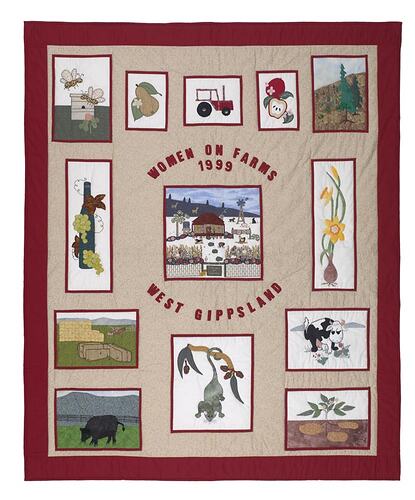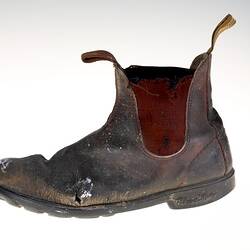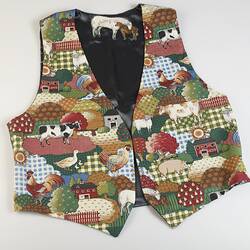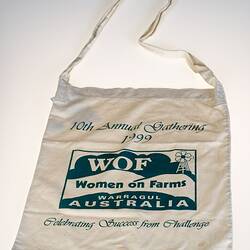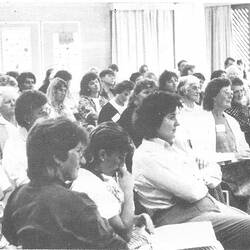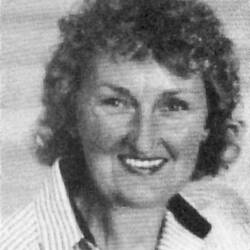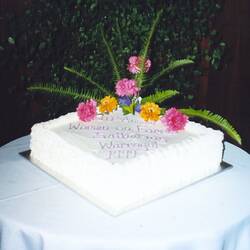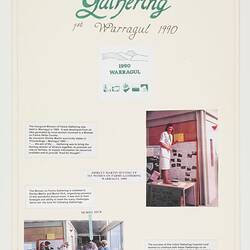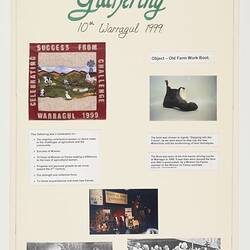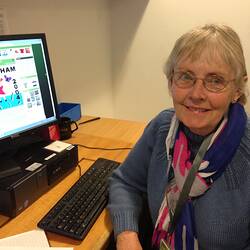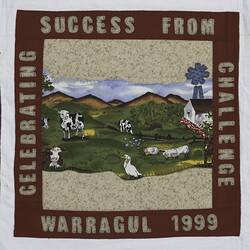Summary
This quilt celebrates the 10th Women on Farms Gathering held in Warragul in 1999 and was on display for the duration of this Gathering.
The idea for the quilt was initiated by Quentin O'Keefe in May 1998, a new farmer to the area and member of the West Gippsland Women on Farms. The design was inspired by a quilt design sourced by Lyn Johnson, a member of the West Gippsland Women on Farms, who acquired it directly from contacts in the Linn-Benton, Chapter, Oregon Women for Agriculture, USA.
13 quilted and embroidered panels illustrate the many elements of rural life and farming enterprises in West Gippsland region. For example: timber from Powelltown and Narracan, daffodils from Ellinbank, a dairy cow and an Angus cow common in the region, potatoes from Thorpdale, wine from Warragul, apples and pears from Cora Lynn, and a grey 'Fergy' tractor. The terracotta sashing represents the rich soils of West Gippsland.
Quilt design, layout, machine assembly, hand piecing and hand quilting were undertaken over a six month period by members of West Gippsland Women on Farms: Jan Slater, Margaret Gray, Margaret Roots, Quentin O'Keefe and Pauline Mathews.
"Our quilt is very much a product of place, from Oregon USA to West Gippsland, Victoria. The Oregon women understood the significance of a quilt as a tool to document place and as an experience that bonds women through the shared activity. They were only too happy to help and sent the pattern within three days! A quilt also represents a time in the lives of the quilters when it was a distraction from the difficulties of family problems, unemployment and illness. While it commemorates the 10th Gathering and documents land use in Gippsland, the quilt also represents the last six months of the life of Keith, the husband and brother of two of the quilters. The realities that faced us as rural women are stitched in that quilt through the experiences and feelings that were shared in its creation. The appearance of the quilt at the Warragul Gathering connected me immediately to quilting women farmers from diverse places. Quilts have been a feature of Gatherings since this first appearance in 1999." Quentin O'Keefe.
Part of Museums Victoria's Invisible Farmer Project Collection. The Invisible Farmer Project was the largest ever study of Australian women on the land, uncovering the histories and stories of Australian women in agriculture. It began as a pilot project (2015-2016) and evolved into a three year (2017-2020) nation-wide partnership between rural communities, academic, government and cultural organisations, funded by the Australian Research Council.the absence of rural women in mainstream histories and museums.
Physical Description
The quilt is made of pre-washed cotton fabric in many colours, both plain and printed, with hand embroidery and applied embellishments such as plastic eyes, beads and buttons. It is constructed in three layers, the front or top is the design, the back is plain and the middle layer is wool batting The background is a beige mottled print with 13 quilted and embroidered panels, each framed with a narrow dark red border applied to the 'field' by hand. The designs on each panel and the narrow frames are delineated with hand quilting. The words "WOMEN ON FARMS, 1999" and "WEST GIPPSLAND" are in single letters applied by hand. A wide border in dark red surrounds four sides and a narrow border in the same dark red has been used to bind the edges by machine stitching on the front of the quilt and hand stitching to the back. The back is plain cream fabric, with a long open ended panel at both top and bottom edges to enable hanging rods to be inserted. There is a fabric label sewn to the bottom left corner of the back. By dividing the quilt into 3 vertical sections, the panels are: LEFT SECTION - bees and a hive in a field with a flower, wine bottle and grapes, horses in a field with hay bales and a bull in a paddock. CENTRE SECTION - a pear, a tractor, apples, lettering as above, a homestead and garden behind a picket fence, and a possum hanging from a branch with eucalyptus leaves and gumnuts. RIGHT SECTION - pinetree plantation, daffodils, a cow in a field and potatoes. The label on the back has the following information hand printed in a permanent black ink. "Country Spirit" celebrates the 10th Gathering of Women on Farms, West Gippsland 1999." This quilt represents the many facets of rural life in West Gippsland and the spirit of the women who contribute to the growth and prosperity of the area. "Stitches of friendship, threads of support, woven together for all to enjoy." Jan S. Quilt design, layout, machine assembly, hand piecing and hand quilting by member of West Gippsland: Jan Slater, Margaret Gray, Margaret Roots, Quentin O'Keefe, Pauline Matthews. Inspired by Linn Benton Chapter, Oregon Women for Agriculture. Signed Jan S, Marg G, Marg R, Q. O'Keefe, Pauline M. It is embellished with three grub roses hand embroidered in bullion stitch, surrounded by green leaves in detached chain stich and stem stitch.
Significance
Historical and Technical Significance:
This quilt celebrates the 10th anniversary of the Women on Farms Gathering, Warragul, 1999, and was on display for the duration of this Gathering. The quilt has been on public display at Warragul and formed part of the Women on Farms Gathering Community Collections display at Melbourne Museum in 2005.
The historical and spiritual significance of the quilt has been articulated by Quentin O'Keefe, the woman who initiated its creation, and is a member of the Women on Farms Gathering Heritage Group:
The use of communal rituals and practices at Gatherings creates a spiritual place for participants and organisers. One particular practice that has emerged in recent years has been communal quilt making.
"In May 1998, I inadvertently became involved in the initiation of a new ritual of the Gatherings when I suggested that a quilt be made for the 10th Gathering in Warragul. My suggestion for a quilt had been met with polite silence and, for a short time, I thought that I would have to make it myself. From this unpromising start, a group of quilting women farmers emerged.
One of the local farming women had connections with the Linn-Benton Chapter, Oregon Women for Agriculture, United States of America, who provided a pattern of their quilt. From this, we designed our images of farming enterprises in West Gippsland, images such as timber from Powelltown and Narracan, daffodils from Ellinbank, a dairy cow and an Angus cow so common in the region, potatoes from Thorpdale, wine from Warragul, apples and pears from Cora Lynn and a grey 'Fergy' tractor. The terracotta sashing represents the rich soils of West Gippsland. However, in keeping with the tradition of quilt making, the practice created deep layers of meaning for those involved.
The quilt is very much a product of place, from Oregon USA to West Gippsland, Victoria. The Oregon women understood the significance of this quilt as a tool to document place and as an experience that bonds women through the shared activity and sent the pattern within three days. It also represents a time in the lives of the quilters when it was a distraction from the difficulties of family problems, unemployment and illness. While it commemorates the 10th Gathering and documents land use in Gippsland, the quilt also represents the last six months of the life of Keith, the husband and brother of two of the quilters. The realities that faced us as rural women are stitched in that quilt through the experiences and feelings that were shared in its creation.
The appearance of the quilt at the Warragul Gathering connected me immediately to quilting women farmers from diverse places. Quilts have been a feature of Gatherings since this first appearance in 1999."
More Information
-
Collection Names
-
Collecting Areas
Clothing & Textiles, Home & Community, Sustainable Futures, Working Life & Trades
-
Acquisition Information
Donation from Women on Farms, West Gippsland, 13 Oct 2006
-
Creator
Margaret Roots - Women on Farms, West Gippsland, Longwarry, Gippsland, Victoria, Australia, 1999
-
Creator
Jan Slater - Women on Farms, West Gippsland, Warragul, Gippsland, Victoria, Australia, 1999
-
Creator
Margaret Gray, Nar Nar Goon, West Gippsland, Victoria, Australia, 1999
-
Creator
Quentin O'Keefe - Women on Farms, West Gippsland, Warragul, Gippsland, Victoria, Australia, 1999
-
Creator
Pauline Matthews - Women on Farms, West Gippsland, Warragul, Gippsland, Victoria, Australia, 1999
-
Designer
Linn Benton Chapter, Oregon Women for Agriculture, Oregon, United States of America, 1999
-
Commissioned By
Women on Farms, West Gippsland, Warragul, Gippsland, Victoria, Australia, 1998
-
Commissioned By
Mrs Lyn Johnson - Women on Farms, West Gippsland, Warragul, Gippsland, Victoria, Australia, 1999
-
Classification
Agriculture & rural life, Community activity - women on farms gathering, Quilts
-
Category
-
Discipline
-
Type of item
-
Overall Dimensions
1890 mm (Width), 5 mm (Depth), 2340 mm (Height)
-
References
We have several oral histories and images relating to this quilt. [Link 1] viewed 12.05.2008 LDH [Link 2] viewed 12.05.2008 LDH
[Chapter] Dale-Hallett, Liza, et al. "Rural women reclaiming their place through symbols, stories and rituals"., 2008
[Article] Dale-Hallett, Liza & Diffey, Rhonda. 2006. "Motherboards and desert sands: stories of Australian rural women" Frontiers: A Journal of Women's Studies., 2006
[Article] Dale-Hallett, Liza, et al. 2006. "Creating collaborative living history; the case of the Victorian Women on Farms Gathering Heritage Collection", History Australia., 2006
-
Keywords
Agriculture, Banners, Community Groups, Community Organisations, Cotton Fabrics & Textiles, Crafts, Gender Roles, Globalisation, Politics, Rural Life, Rural Victoria, Textile Technology, Work
